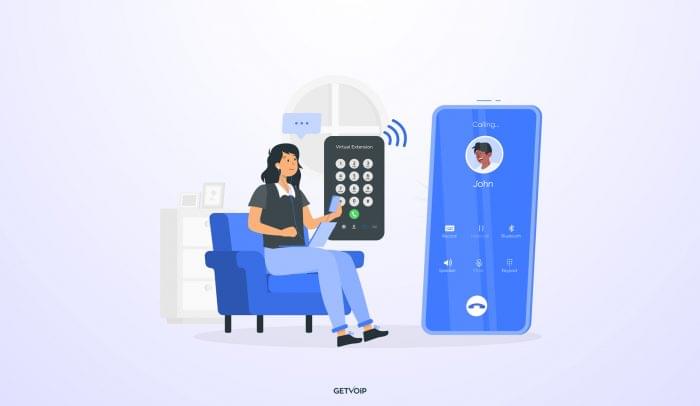Your business needs a dynamic call receiving system that moves with your employees, which is why virtual extensions have become a popular feature for many SMBs. This is a unique business VoIP solution that helps your employees stay in touch with contacts, even when they are on the run and only have their smart devices.
What is a Virtual Extension?
A virtual extension, which is a type of virtual phone number technology, is a VoIP system that forwards inbound calls so that users can receive them on smart devices or wherever they prefer. The virtual number is not associated with any specific desk and most often forwards to a preset device or location.
If the person who is being called at the virtual extension cannot be reached, the virtual extension has its own voicemail, which is separate from the user’s home/cell voicemail. In effect, the virtual extension is like the remote call forwarding/find me, follow me feature, only it is set to go to the second number first.
Today, there are many reasons to work from home or to be in the field, but there are potential drawbacks. The most obvious is the lack of separation between home and personal life. For example, it isn’t that difficult to have a neutral outgoing voicemail that’s appropriate for friends and clients alike, but what about the voicemail box itself? Your voicemail and your address book can get cluttered with content coming from both sources.
A virtual extension ensures that personal and business correspondence is separate and managed independently, even if accessed on the same device. Business calls come to your device first, and personal numbers and inboxes are neatly partitioned.
How Virtual Extensions Benefit Business
Virtual extensions allow all employees to be part of the same phone system, even if they use their own phones to receive important work calls. This makes the virtual extension a powerful tool for small businesses.
Virtual extensions also create the appearance of a larger and/or unified organization. One of the biggest problems that nascent businesses face is how to best communicate. Customers can reach the right department by interacting with the auto attendant, which then forwards the call to the virtual extension.
A virtual extension can be, and often is, a seven-digit number that is directly dialed by customers. However, that number is the office’s number, not the employee’s personal number. It can also be in numerical sequence with the other numbers of that business, which is good for optics.
A virtual extension can also be used for numbers that aren’t associated with people at all. A virtual mailbox with just an outgoing message can relay hours and driving directions or give promotional offers and coupon codes. A virtual mailbox can also be used as an after-hours technical support mailbox. Some businesses provide after-hours emergency support; a text or email alert goes out to all the technicians on call, and whomever can give the best technical support at that time will get in touch with the customer as soon as possible.
All calls routed through the voicemail also get recorded in phone logs, rather than your personal phone calls. All the calls and voicemails are accessible via unified voicemail. Virtual rules also follow the same calling rules as any other extension, so you can set rules based on the caller and the time of day to let calls go through or to go directly to voicemail.
Most importantly, an extension of this type is completely separate from your personal number; things like business voicemails are accessible without interacting with your personal mails.
Standard vs. Virtual Extensions
With a regular extension, you will have access to most business phone needs like local and long-distance calling and concurrent calls. Typically, unlimited inbound and outbound calls are provided with this type of extension, but virtual extensions only give the business access to unlimited inbound calls. This means that the cost of sending calls to anyone on-site will be far less with virtual extensions.
With a cloud PBX, these extensions are routed off of the main phone number. The transfer can be made without additional hardware, and they can be collectively placed on hold until an agent is available to take the call. This means that extensions are not limited, and the customer will not easily be able to tell when they are being transferred unless they are directly told so by an agent. In fact, customers will not be able to tell the difference between a traditional and a virtual extension.
Create a Local Presence with Virtual Extensions
Another reason for businesses to get a virtual extension is because they can also be used as a local number, which then forwards directly to the main number. This allows you to target a specific area that may present a lot of leads for the company, and make it look like the business is actually based there.
According to Small Business Trends, 91% of customers prefer dealing with small, local businesses when it is convenient. Regardless of where the actual office is, a virtual extension creates a local presence anywhere in the world. With VoIP, every call is a local call.
Looking for a reliable way to manage inbound calls? IVR provides you with unique customer engagement options and even helps your business provide self-service for your customers. If you don’t know where to start when it comes to these systems, check out our IVR systems guides so that you know more about providers and the key features these systems offer.



